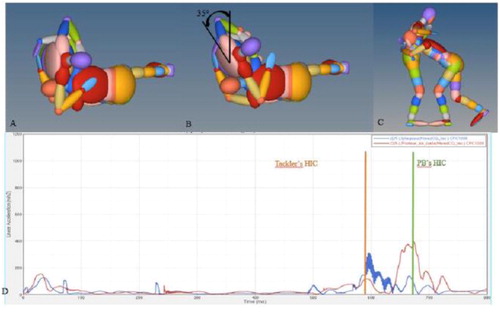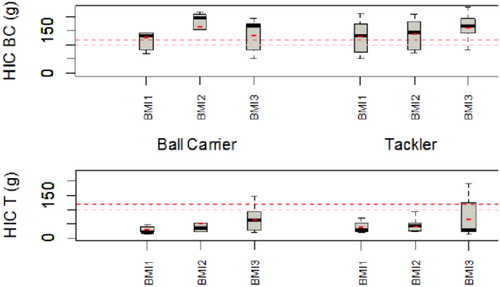Keywords:
1. Introduction
Recent news in Rugby Union highlight the necessity to prevent concussions and injuries during training and matches. The number of concussions has indeed been reported to increase in the last decades (Finch et al. Citation2013). This is mostly due to the anatomy of professional rugby players (muscular development, higher body mass index- BMI).While the rugby union rules have been changing to promote safer practice in scrum, the players get highly injured during tackles (Fuller et al. Citation2010). Multiple influences on injury risks, such as the impact conditions or the player’s morphology, have not been fully studied. In tackling, both the tackler (T) and the ball carrier (BC), their morphology and initial position need to be studied to fully describe the tackle impacts. Experimentally, on field data can be acquired with sensors and epidemiological studies have been carried to correlate the type of injury with the impact conditions (Kuster et al. Citation2012).
The injury risks associated with head and neck have been quantified through deferent indices. The Head Injury Criteria (HIC), which correlates the seriousness of an head injury with decelerations along the time (Viano Citation2005). The head’s angular acceleration has also been associated with shear strain that could cause brain injury (Patton et al. Citation2012). Indeed, those data are required to diagnose and predict players’ injuries.
While lowering the required computer resources, the multi-body analysis enables the estimation of such initial conditions (Tierney and Simms Citation2017). Various multi-body models exist and can been used depending on the application and their range of motion calibration.
This work aims 1) to quantify the injury risk associated to different types of tackle, 2) to quantify the influence of morphology and conditions of impact, and 3) to identify potential best practices that need to be promoted for a safer play.
2. Methods
2.1. Multi-body simulation
The Pedestrian Ellipsoid Model (PEM) () was developed by Tass international© in the MADYMO environment. The TNO PEM consists of 52 rigid bodies and includes six frangible joints in each leg. This model can be scaled to any required body size using GEBOB program. Such model has been calibrated for the kinematic of the head impact during a pedestrian collision and has been used to estimate the neck force and the head acceleration in motor researches.
2.2. Parametric study
Three parameters are studied: The BMI of BC and T and the angle of pre-tackle. The BMIs are set to 27.8, 26.3 and 31.6 kg.m−2 for both players (respectively 1.75 m/85 kg, 1.95 m/100 kg and 1.95 m/120 kg). The angles of pre-tackle are set to 0°, 35° and 80° (). This results in a total of 27 simulations.
2.3. Post-processing and statistical analysis
Maximum forces applied at junction between the head and the neck for both players are computed. Both linear and angular accelerations are evaluated at the centre of mass of the head. HIC for both players are computed as the integration of the linear acceleration during 15 ms chosen to maximize this value (). The sensitivity of each parameter is assessed using ANOVA and the comparison between simulations using Wilcoxon test.
3. Results and discussion
The 27 simulations ran in 20 min in average. The changes in pre-tackle angle appear to have a different influence on neck force for BC and T. The neck force on BC was found higher for the 35° situation while it decreases with the increasing pre-tackle angle for T reaching 2370.9 ± 243.8 (N) in average at 0°. The accelerations and HIC for BC increased with decreasing angle. On the opposite T’s angular acceleration increased with increasing angles. The linear acceleration and HIC are then found higher for the 35° configuration for T.
The HIC and linear acceleration of BC is found significantly higher than T’s (p < 0.001). The angular acceleration is higher for T than for BC ().
Table 1. Influences of the pre-tackle angle on neck forces, linear and angular acceleration for BC and T.
While trends are visible for T’s BMIs, no significant difference between BMIs were found on the sample of simulated situations. Further simulations are required to conclude ().
Compared to previous studies reporting head impact in sport (King et al. Citation2015), linear and angular accelerations computed here are in the same range (36.74 ± 9 g for linear acceleration and 3620 ± 3605 rad.s−2 angular acceleration for King et al. Citation2015)
Limitations: the calibration and the validation of the model could be improved. We could confront those results with experimental tests, which reconstructed tackle in Rugby or in American and Australian football. The setting of the multi-body model could also be modified to take into account the players’ head position and the tackle height.
4. Conclusions
Those first results show the feasibility of the multi-body analysis for the determination of initial impact conditions of rugby tackle, which could be used for future finite element modelling of the head and neck.
Acknowledgements
We thank Pierre-Jean Arnoux for his support and expertise.
References
- Finch CF, Clapperton AJ, McCrory P. 2013. Increasing incidence of hospitalisation for sportrelated concussion in Victoria, Australia. Med J Aust. 198(8):427–430.
- Fuller CW, Ashton T, Brooks JHM, Cancea RJ, Hall J, Kemp S. 2010. Injury risks associated with tackling in rugby union. Br J Sports Med. 44(3):159–167.
- King D, Hume PA, Brughelli M, Gissane C. 2015. Instrumented mouthguard acceleration analyses for head impacts in amateur rugby union players over a season of matches. Am J Sports Med. 43(3):614–624.
- Kuster D, Gibson A, Abboud R, Drew T. 2012. Mechanisms of cervical spine injury in rugby union: a systematic review of the literature. Br J Sports Med. 46(8):550–554.
- Patton DA, McIntosh AS, Kleiven S, Fréchède B. 2012. Injury data from unhelmeted football head impacts evaluated against critical strain tolerance curves. Proc Imeche. 226:177–184.
- Tierney GJ, Simms CK. 2017. The effects of tackle height on inertial loading of the head and neck in Rugby Union: a multibody model analysis. Brain Inj. 31(13–14):1925–1931.
- Viano DC. 2005. Head impact biomechanics in sport. In: Gilchrist MD, editor. IUTAM symposium on impact biomechanics: from fundamental insights to applications. Amsterdam: Springer Netherlands; p. 121–130.


